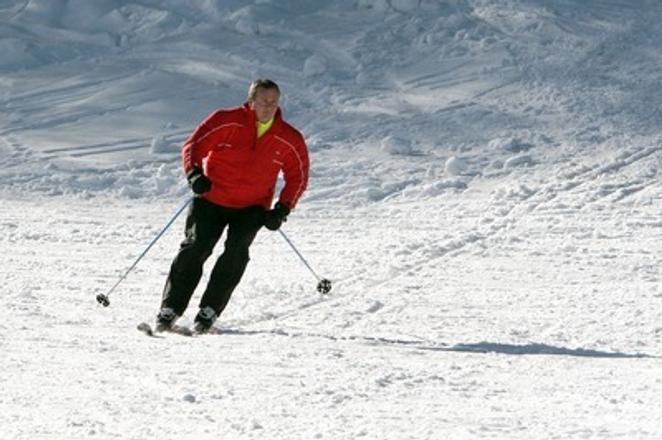In Slovakia, one of the most popular hubs for skiing, about 20 knee injuries are reported daily every season. It is obvious that the most common injuries in skiing occur to the lower limb, most commonly the knee due to the high involvement in balancing with the knees. With the introduction of releasable bindings the rate of leg fractures has been diminished by 90% in the past 30 years, but unluckily knee sprains including anterior cruciate ligament medical cruciate ligament have increased accounting for about 30% of all skiing injuries.
Although most skiing related knee injuries have a sound prognosis, some may lead to high functional impairment and even stop someone from his skiing carrier. It is important to diagnose accurately, coupled with suitable investigations and treatment, as it may be essential in helping the skier to recover from such injuries rapidly and progressively as possible.
Medial (inner) collateral ligament (MCL) tear, is the most common out of both which is typically treated without going for a surgery. MCL is often torn while the ski tips are pointed toward one another in a snowplow position in a stop or reducing the speed and the skier falls down the steep. Beginning and intermediate skiers are mostly victimized than advanced and elite skiers to MCL injuries
Anterior cruciate ligament (ACL, also called cruciform ligament as it arranged in a crossed formation inside the knee joint) tear being the second most common injury may lead to bigger complications as ACL helps the functional stability of the knee, that ACL tears sometimes require surgery. Patients can avoid surgery in some minor damage to ACL ligament. Two most common ways that skiers tear the ACL are as follows:
Poor landing techniques - Skiing encompasses a lot of jumping specially in the elite form. While landing from a jump with the weight backward directed, the back of the boot pushes on the calf, and theintense force from landing may tear up the ACL. Learn to land safely with the best technique with your weight forward, is the best way to avoid ACL tear up and starting with simple jumps up to a gradual advancement to more difficult jumps may do the best.
"Phantom foot" phenomenon - This often occurs when skiers try to stand up to get rid of an inescapable fall. All the weight points on the outside of one ski, rotating the arms and trunk away from that leg, as the skier falls. This type of position falling may inevitably lead to an ACL injury. Get used to accept an unavoidable falland never trying to stand up during a fall are the simplest method to prevent ACL injury. Skiers should "propel" with the momentum of a fall and maintaining good ski technique is the key.
Tibial plateau fractures (proximal part of the shinbone) are another type of rarely occurred injuries that account for approximately 1% of all ski injuries and usually affect older, more experienced skiers. Severe valgus stress, where the bone or joint is twisted outward from the center of the body. with compressive forces to the distal part of lower limb, that results as a bad landing after a jump. Bleeding to the joint capsule is usual and if bruising and/or abrasions over the lateral aspect of the joint are present special attention should be taken after the injury. Prevention can be improved by getting used with the proper techniques of landing after a jump.
Meniscal injuries which occur in approximately 5 –10% of all ski injuries, is normally associated with damage to another adjacent structure. Due to a valgus twist in a weight bearing knee, this happens usually to the lateral (outer) meniscus. When a rotational stress is applied to a flexed, weight bearing knee while catching an edge at speed, this may occur. Considerable pain in the knee joint, difficulty weight bearing plus a little swelling can be felt after an injury. Using the proper technique while landing and speed altering may prevent this type of injuries to a greater degree.
Slope injury prevention
To prevent the above injuries mostly happens while driving down slopes, keep in mind the keys to effective skiing technique: weight and hands forward, legs parallel while hips, knees, and ankles flexing equally. Always try to stay on marked trails that going off trail can lead you into scraggly territory with many obstacles like trees and rocks that can contribute to unexpected injuries.
Before stepping into the slopes prepare your body with a few simple exercises like Side plank, Side-to-Side Skaters, Single Leg Squats and Double Leg Squats as these can prepare your core and lower extremities for skiing. Aerobic training such as walking, swimming or biking for around a month can greatly help you to tolerate a full day on the slopes.
Make sure your ski boots, bindings, and ski length are pin point fit and appropriate for your height as well as skill level. Don’t forget your head; always wear a helmet and wrist guards play a role in preventing skiing injuries. Take a skiing technique class from a professional player before you hit the slopes and take your time for a rest if you are tired as injuries are more common when skiers are fatigued. Always stick to territory that is not an overwhelming challenge and make sure that you are always in a balanced weight while attempting snowplow position.
By Radoslav Zamborsky MD. ,PhD., Orthopedic Trauma Consultant, University Hospital in Bratislava


 (source: Sme)
(source: Sme)